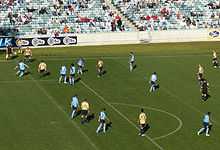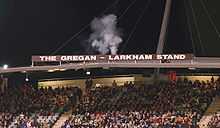Canberra Stadium known for sponsorship reasons as GIO Stadium Canberra, is a facility primarily used for rugby league and rugby union games, located adjacent to the Australian Institute of Sport in Canberra, the capital of Australia.
History
Constructed in 1977 for the Pacific Conference Games, it also was the venue for the 4th IAAF World Cup in Athletics. At the latter meet, the still-current world record for the women's 400m was recorded by East German Marita Koch, and a world record for the women's 4x100m was set by East Germany and stood until the 2012 London Olympic Games.
In the late 1980s the running track was removed and re-located to the warm up stadium at the AIS site. In the 1990 NSWRL season, the reigning NSWRL premiers the Canberra Raiders moved to Bruce Stadium from Seiffert Oval in Queanbeyan, their home ground since entering the NSWRL in 1982. The Raiders won their second straight premiership in 1990.
The removal of the track meant that Australian rules football, more specifically the Australian Football League (AFL), could now be played at the ground. In 1995, an AFL match for premiership points was contested between the West Coast Eagles and Fitzroy. There were also a number of pre-season AFL games played at the venue, mostly featuring the Sydney Swans.
Also around this time, as an experiment, a cricket pitch was placed in the centre of the ground, and a day/night 1 day cricket match was played between 2 local teams before a small crowd. Regular cricket matches on the ground did not eventuate.

Sydney FC playing Newcastle at Canberra Stadium in 2006
Further renovations occurred in 1997 in preparation for staging soccer matches as part of the 2000 Summer Olympics in Sydney, which also in turn shrank the size of the playing field preventing any future Australian rules football games being played on the field. The final cost of the renovations was more than seven times what was originally anticipated by the territory government of the time, and the subsequent controversy ended the career of then Chief Minister Kate Carnell. During the lead-up, on 28 May 2000, unseasonal snow fell during a match between the Raiders and the Wests Tigers, the only such event in National Rugby League history, with the snow causing frost damage to the turf intended for the Olympic football tournament.
Olympic soccer in 2000 has initiated a stadium facelift converting the playing surface from oval to rectangular and bringing the crowd closer to the action.[2] The only downside to this revamp is the stadium can no longer host AFL games. It is now an all-seater rectangular stadium with two main grandstands on either side of the playing field. As a result, all major cricket and Australian Rules football games in Canberra are now staged at the 15,000 capacity Manuka Oval.
A 2008 Rugby League World Cup Group B game between Scotland and France was played at Canberra Stadium, the first ever rugby league test played at the venue. France defeated Scotland 36-16.
In 2009 there was an A-League bid from Canberra that, if successful would have seen a team play at the stadium starting with the 2010–11 season. However, the league chose to award second teams to Sydney Rovers FC (which dissolved due to financial issues) and Melbourne Heart FC.
Ownership
The stadium is currently owned by the Australian Government through the Australian Sports Commission and leased to the Australian Capital Territory Government. While the current lease is due to expire in 2010, the ACT Government is seeking ownership of the stadium through a land transfer with the Australian Government.
Seating and Capacity
Capacity is a nominal all-seated 25,011, the largest crowd being 28,753 for the 2004 Super 12 Final. The main grandstand is named after Canberra Raiders and Australian rugby league player Mal Meninga, and a statue of another Raiders and Australian league representative Laurie Daley adorns the main grandstand entrance.

Unveiling of the Gregan-Larkham stand at Canberra Stadium on 28 April 2007.
The eastern grandstand was named the Gregan/Larkham Grandstand on 28 April 2007, after Brumbies and Australia rugby union greats George Gregan and Stephen Larkham. Both ended their international careers after the 2007 Rugby World Cup as the two most-capped players in Wallabies history (at that time), with Gregan at a world-record 139 and Larkham at 102.
Crowd records
Rugby union
Rugby league
Soccer
Australian Rules Football
Possible Replacement
Whilst the stadium suits the needs of its two current primary tenants, as of 2011 it will be the second-smallest Super Rugby stadium (behind the Western Force's nib Stadium), and only a medium-sized NRL venue. The stadium itself is approaching 35 years old, and despite modernizations over the years is lacking in certain amenities for fans – especially covered seating.
Additionally, Australia had bid for the 2022 FIFA World Cup and Canberra Stadium does not meet the necessary criterion to host matches. As such, the ACT Government launched a study examining the upgrading or replacing of Canberra Stadium, with options ranging from increasing capacity and enclosing the current facility, to completely re-configuring the current stadium to an oval for cricket and Australian rules football and building a state of the art rectangular facility next door.[4]
Citing costs of building multiple facilities as an issue, ACT Sports Minister Andrew Barr indicated his preference would be a 'super stadium' built with World Cup standard facilities and capacity, able to be reduced to approximately 30,000 seats after the event. Such a facility would have to incorporate movable seating in order to accommodate all of the major Australian sporting codes.[5]
The official bid for the 2022 World Cup indicated that the 'super stadium' plan was unlikely and the original plan of a new rectangular stadium built next door to the current stadium, with the existing facility re-configured for oval field sports, was considered to be the likely outcome.[6]
After the failed world cup bid a new rectangular covered stadium was proposed for Canberra.[7] In 2013 the ACT government announced plans to build a 30,000 covered (with a roof similar to Forsyth Barr Stadium) rectangular stadium in the city on the shores of Lake Burley Griffin. It would be part of a 15 year significant redevelopment of the foreshore which extends the city to the Eastern Basin. Along with the stadium, as part of the redevelopment there would be apartments, a convention centre and an urban beach.[8] Plans to build a new stadium have, however, been put on hold indefinitely due to the need for funds to compensate local residents over an asbestos home insulation debacle.[9] Plans to construct the new stadium have since been pushed back by a decade.[10]
Other Notable Events
Rugby League Test Matches
List of rugby league Test matches played at the Canberra Stadium.[11]
2015 AFC Asian Cup
| Date |
Time (UTC+11) |
Team #1 |
Res. |
Team #2 |
Round |
Attendance |
| January 10, 2015 | 16:00 |  South Korea South Korea | 1–0 |  Oman Oman | Group A | 12,552 |
| January 11, 2015 | 18:00 |  United Arab Emirates United Arab Emirates | 4–1 |  Qatar Qatar | Group C | 5,513 |
| January 13, 2015 | 18:00 |  Kuwait Kuwait | 0–1 |  South Korea South Korea | Group A | 8,795 |
| January 15, 2015 | 18:00 |  Bahrain Bahrain | 1–2 |  United Arab Emirates United Arab Emirates | Group C | 7,925 |
| January 18, 2015 | 20:00 |  China PR China PR | 2–1 |  North Korea North Korea | Group B | 18,457 |
| January 20, 2015 | 18:00 |  Iraq Iraq | 2–0 |  Palestine Palestine | Group D | 10,235 |
| January 23, 2015 | 17:30 |  Iran Iran | 3–3 (a.e.t) (Penalties: 6–7) |  Iraq Iraq | Quarter-finals | 18,921 |
References
External links
|
|---|
| | New South Wales | |
|---|
| | Queensland | |
|---|
| | Victoria | |
|---|
| | ACT | |
|---|
| | New Zealand | |
|---|
| | Former grounds | |
|---|
| | Semi-permanent grounds | |
|---|
|
|
|---|
| | Australia | |
|---|
| | New Zealand | |
|---|
| | South Africa | |
|---|
| | Secondary stadiums (2014) | |
|---|
|
|
|---|
| | | | Club | |
|---|
| | Home Grounds | |
|---|
| | Culture | |
|---|
| | Important figures | |
|---|
| | League | |
|---|
| | Premierships (3) | |
|---|
| | Seasons (28) |
- 1980
- 1981
- 1982
- 1983
- 1984
- 1985
- 1986
- 1987
- 1988
- 1989
- 1990
- 1991
- 1992
- 1993
- 1994
- 1995
- 1996
- 1997
- 1998
- 1999
|
|---|
| | Other competitions | |
|---|
| | Affiliations | |
|---|
|
|
|---|
| | Current Stadiums | |
|---|
| | Former Stadiums | |
|---|
| | ABL 89-99 era Stadiums | |
|---|
|
|
|---|
| | | | World Tours | |
|---|
| | 3-Test series | |
|---|
| | 2-Test series | |
|---|
| | 1-Test series | |
|---|
| | Cancelled series | |
|---|
| |
|
|
|---|
| | Main grounds: | |
|---|
| | Secondary grounds: | |
|---|
| | Future grounds: | |
|---|
| | Former grounds: | |
|---|
|
|
|---|
| | Sydney Olympic Park | |
|---|
| | Sydney | |
|---|
| | Outside Sydney | |
|---|
|
|
|---|
|
- 1900
- Vélodrome de Vincennes
- 1904
- Francis Field
- 1908
- White City Stadium
- 1912
- Råsunda IP, Stockholm Olympic Stadium (final), Tranebergs Idrottsplats
- 1920
- Jules Ottenstadion, Olympisch Stadion (final), Stade Joseph Marien, Stadion Broodstraat
- 1924
- Stade Bergeyre, Stade de Colombes (final), Stade de Paris, Stade Pershing
- 1928
- Monnikenhuize, Olympic Stadium (final), Sparta Stadion Het Kasteel
- 1936
- Hertha-BSC Field, Mommsenstadion, Olympiastadion (final), Poststadion
- 1948
- Arsenal Stadium, Champion Hill, Craven Cottage, Cricklefield Stadium, Empire Stadium (medal matches), Green Pond Road, Griffin Park, Selhurst Park, White Hart Lane
- 1952
- Helsinki Football Grounds, Kotka, Lahti, Olympic Stadium (final), Tampere, Turku
- 1956
- Melbourne Cricket Ground (final), Olympic Park Stadium
- 1960
- Florence Communal Stadium, Grosseto Communal Stadium, L'Aquila Communal Stadium, Livorno Ardenza Stadium, Naples Saint Paul's Stadium, Pescara Adriatic Stadium, Stadio Flaminio (final)
- 1964
- Komazawa Olympic Park Stadium, Mitsuzawa Football Field, Nagai Stadium, Tokyo National Stadium (final), Nishikyogoku Athletic Stadium, Ōmiya Football Field, Prince Chichiba Memorial Football Field
- 1968
- Estadio Azteca (final), Estadio Cuauhtémoc, Estadio Nou Camp, Jalisco Stadium
- 1972
- Drei Flüsse Stadion, ESV-Stadion, Jahnstadion, Olympiastadion (final), Rosenaustadion, Urban Stadium
- 1976
- Lansdowne Park, Olympic Stadium (final), Sherbrooke Stadium, Varsity Stadium
- 1980
- Dinamo Stadium, Dynamo Central Stadium, Grand Arena, Grand Arena (final), Kirov Stadium, Republican Stadium
- 1984
- Harvard Stadium, Navy–Marine Corps Memorial Stadium, Rose Bowl (final), Stanford Stadium
- 1988
- Busan Stadium, Daegu Stadium, Daejeon Stadium, Dongdaemun Stadium, Olympic Stadium (final)
- 1992
- Estadi de la Nova Creu Alta, Estadi del FC Barcelona (final), Estadio Luís Casanova, La Romareda, RCD Espanyol Stadium
- 1996
- Florida Citrus Bowl, Legion Field, Orange Bowl, RFK Memorial Stadium, Sanford Stadium (final)
- 2000
- Stadium Australia, Brisbane Cricket Ground, Bruce Stadium, Hindmarsh Stadium, Melbourne Cricket Ground, Olympic Stadium (men's final), Sydney Football Stadium (women's final)
- 2004
- Kaftanzoglio Stadium, Karaiskakis Stadium, Olympic Stadium (final), Pampeloponnisiako Stadium, Pankritio Stadium, Panthessaliko Stadium
- 2008
- Beijing National Stadium (final), Qinhuangdao Olympic Sports Center Stadium, Shanghai Stadium, Shenyang Olympic Sports Center Stadium, Tianjin Olympic Center Stadium, Workers Stadium
- 2012
- City of Coventry Stadium, Hampden Park, Millennium Stadium, St James' Park, Old Trafford, Wembley Stadium (final)
- 2016
- Estádio Nacional de Brasília, Arena Fonte Nova, Mineirão, Arena Corinthians, Arena da Amazônia, Estádio Olímpico João Havelange, Maracanã (final)
| |
|
|
|---|
| | | | Sporting teams based in the Australian Capital Territory |
|---|
| |
| | | | |
|
|
|---|
| | Buildings and structures | |
|---|
| | Precincts | |
|---|
| | Parks and open spaces | |
|---|
| | Cultural institutions | |
|---|
| | Sport | |
|---|
| | Transportation | |
|---|
| | Entertainment | |
|---|
| | Beaches and islands | |
|---|
|


 Australia vs
Australia vs  Germany
Germany United States vs
United States vs  Czech Republic
Czech Republic Australia vs
Australia vs  Kuwait
Kuwait
